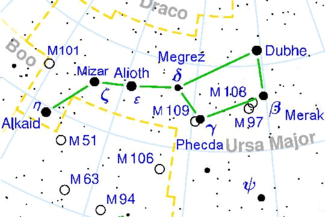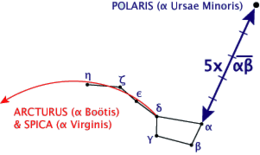|
|
 Big Dipper map The seven brightest stars of the constellation Ursa Major, the Great Bear, form a well-known asterism that has been recognized as a distinct grouping in many cultures from time immemorial. Names and lore Europe In the United Kingdom and Ireland this pattern is known as the Plough (although in northern England it is occasionally referred to as the Butcher's Cleaver). It was formerly called by the old name Charles' Wain ("wain" meaning "wagon," and derived from the still older Carlswæn) as it still is in Scandinavia, Karlavagnen, Karlsvogna or Karlsvognen. This common Germanic name originally meant the men's wagon (the churls' wagon) in contrast to the women's wagon (Little Dipper). A folk etymology holds that it was named after Charlemagne. In Slavic languages and Romanian language, it is known as "Great Wagon", as opposed to "Small Wagon", Little Dipper. In Russia, it is called Big Mother Bear. In German it is called Großer Wagen (Great Cart) or Großer Bär (Great Bear). An older Odin's Wain may lie behind these northern concepts. In Finland the figure is known as Otava and widely used as a cultural symbol. In Finnish dialects, the word otava means a 'salmon net', but this word is largely obsolete in modern Finnish. In Ireland the figure is known as the Starry Plough and has been used as a political symbol. The Casserole (saucepan) is a name for the grouping in southern France. These seven stars ("Septentrio") are the origin of the Latin word septentriones meaning "north" and now found as the adjective septentrional (northern) in English, French, and Spanish. Asia In Hindu astronomy, it is referred to as (Vrihat) Sapta Rishi meaning "The Seven (Great) Sages". Throughout eastern Asia, these stars compose the Northern Dipper. They are colloquially named "The Seven Stars of the Northern Dipper" (Chinese: 北斗七星; pinyin: běidǒu qīxīng; Japanese Romaji: hokuto shichisei; Korean: Hangul: 북두칠성, Romaja: Bukduchilseong; Vietnamese : chòm sao Bắc Đẩu). Sometimes there are said to be nine stars -- two invisible "attendant" stars, one on either side of the star Alkaid. These probably refer to two nearby Messier objects. In Malaysia,it is known as Buruj Biduk (The Ladle). An Arabian story has the four stars of the dipper's cup as a coffin, with the three stars in the handle as mourners, following it.[1] North America n North America it is known as the Big Dipper because the major stars can be seen to follow the rough outline of a large ladle or dipper. This figuration appears to be derived originally from Africa, where it was sometimes seen as a drinking gourd. In the 19th century, runaway slaves would reputedly "follow the Drinking Gourd" to the north and freedom. A widespread American Indian figuration had the bowl as a bear. Some groups considered the handle to be three cubs following their mother, while others pictured three hunters tracking the bear. (For example, see Abenaki mythology.) The Dipper appears on some Tribal flags. Other The Bible refers to it as "the seven stars" (Amos 5:8), though some translations have "Big Dipper" explicitly, and some translations of that verse refer to the Pleiades, which also has seven stars visible to the naked eye, instead. In Tolkien's Middle-earth mythos, it is called the Sickle of the Valar, the sign of Hope signifying doom for Evil, while in T.A. Barron's Great Tree of Avalon series, it is called the Wizard's Staff, symbolizing Merlin's staff. In the manga series Fist of the North Star (Hokuto no Ken), the Hokuto in the original Japanese title refers not to the North Star in the official English title, but to the Big Dipper instead (Hokuto literally means Northern Dipper). The main character, Kenshiro, bears seven scars on his chests that forms the same shape as the Big Dipper. The Big Dipper itself or Hokuto Shichisei is a recurring symbolism in the series. Stars Within Ursa Major the stars of the Big Dipper have Bayer designations in consecutive Greek alphabetical order from the bowl to the handle.
Near Mizar is a star called Alcor and together they are informally known as the Horse and Rider. At magnitude 4.1, Alcor would normally be relatively easy to see with the unaided eye, but its proximity to Mizar renders it more difficult to resolve, and it has served as a traditional test of sight. In the 17th century, Mizar itself was discovered to be a binary star system — the first telescopic binary found. The component stars are known as Mizar A and Mizar B. In 1889, Mizar A was discovered to in fact be a binary as well, the first spectroscopic binary discovered, and with the subsequent discovery that Mizar B itself is also a binary, in total Mizar currently is known to be at least a quadruple star system. Five of the stars of the Big Dipper are at the core of the Ursa Major Moving Group. The two at the ends, Dubhe and Alkaid, are not part of the swarm, and are moving in the opposite direction. Relative to the central five, they are moving down and to the right in the map. This will slowly change the Dipper's shape, with the bowl opening up and the handle becoming more bent. In 50,000 years the Dipper will no longer exist as we know it, but be re-formed into a new Dipper facing the opposite way. The stars Alkaid to Phecda will then constitute the bowl, while Phecda, Merak, and Dubhe will be the handle. Guidepost
Not only are the stars in the Big Dipper easily found themselves, but they may also be used as guides to yet other stars. * Polaris, the North Star, is found by imagining a line from Merak (β) to Dubhe (α) and then extending it for five times the distance between the two Pointers. * Extending a line from Megrez (δ) to Phecda (γ), on the inside of the bowl, leads to Regulus (α Leonis) and Alphard (α Hydrae). A mnemonic for this is "A hole in the bowl will leak on Leo." * Crossing the top of the bowl from Megrez (δ) to Dubhe (α) takes one in the direction of Capella (α Aurigae). A mnemonic for this is "Cap to Capella." * Castor and Pollux (α and β Geminorum) can be located by crossing the bottom of the bowl from Phecda (γ) to Merak (β) and continuing onward. * By following the curve of the handle from Alioth (ε) to Mizar (ζ) to Alkaid (η), one reaches Arcturus (α Boötis) and Spica (α Virginis). A mnemonic for this is "Arc to Arcturus then speed to Spica." Also, the approximate location of the Hubble Deep Field can be found by following a line from Phecda (γ) to Megrez (δ) and continuing on for the same distance again. Similarly, the approximate location of the bright galaxies M81 and M82 can be found by following a line from Phecda (γ) to Dubhe (α) and continuing on for the same distance again. See also * Ursa Major, the constellation of which the Big Dipper is part * Little Dipper * Gallery of astronomical flags Retrieved from "http://en.wikipedia.org/"
|
|
|||||||||||||||||||||||||||||||||||||||||||
